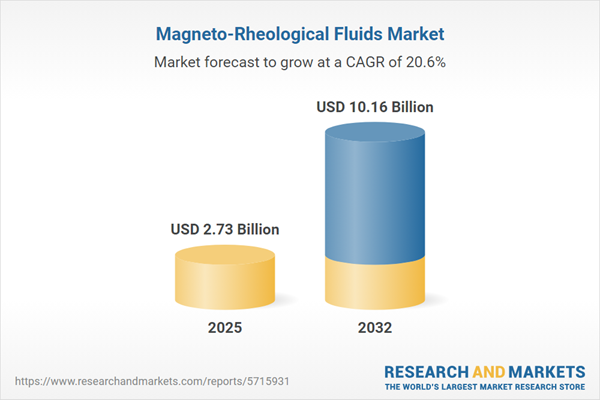Speak directly to the analyst to clarify any post sales queries you may have.
The magneto-rheological fluids market is gaining momentum as an integral solution for organizations pursuing greater operational flexibility, advanced automation, and resilient manufacturing processes in today’s evolving industrial environments.
Market Snapshot: Magneto-Rheological Fluids Market—Current Growth and Trends
The magneto-rheological fluids market is undergoing accelerated growth, highlighted by market projections that indicate steady expansion from USD 2.27 billion in 2024 to USD 2.73 billion by 2025, and anticipated progression to USD 10.16 billion by 2032. This growth reflects a strategic focus among leading industries to adopt digital innovations and streamline manufacturing workflows. These fluids are increasingly deployed to deliver fast, adaptive responses as operational needs shift, supporting sophisticated production across verticals such as aerospace, automotive, electronics, and infrastructure. The integration of magneto-rheological fluid technologies is also enabling organizations to respond effectively to fluctuating demands while maintaining robust productivity and adaptability.
Scope & Segmentation: Strategic Overview for Decision-Makers
For senior leaders, understanding the complexities of the magneto-rheological fluids market requires a clear perspective on its segmentation and strategic importance. Segment relevance includes:
- Applications: Vibration control solutions in aerospace; precision damping for industrial settings; adaptable systems within automotive manufacturing; tactile feedback components in electronics; breakthroughs in medical device performance; seismic dampening applications for buildings; and overall vibration management in industrial equipment.
- Fluid Types: Continuous fluids designed for enduring high-stress operations; discrete fluids tailored for responsive and flexible applications in technologically advanced machinery.
- End Use: Aftermarket strategies that extend asset life and minimize downtime; OEM integrations emphasizing initial reliability and long-term operational value.
- Distribution Channels: Direct sales that provide customized technical solutions aligned to client-specific requirements; distribution networks structured for rapid, localized supply across distributed operations.
- Geographic Regions: The Americas, Europe, Middle East and Africa, and Asia-Pacific, each with distinct technology adoption curves and regulatory frameworks, creating different opportunities for innovation and compliance.
- Leading Participating Companies: Industry advancement is propelled by Parker-Hannifin Corporation, BASF SE, Eaton Corporation plc, Nanomagnetics Limited, Guangxi Guilin Gaoda Scientific & Technological Development Co., Ltd., Hebei Guanneng Science & Technology Co., Ltd., and Beijing Huade Magnetoelectric Technology Co., Ltd. through collaboration and ongoing innovation.
Grasping these segmentation insights supports executive teams in prioritizing resources, selecting precise market entry moments, and differentiating within high-value business segments.
Key Takeaways for Senior Decision-Makers
- Magneto-rheological fluids support advanced automation and improved operational efficiency, forming a backbone for organizations intent on boosting productivity in complex workflows.
- Progress in material sciences is unlocking broader application capabilities, resulting in custom-engineered solutions adaptable to tasks in automotive, electronics, and construction sectors.
- The Asia-Pacific region has become a focal point for innovation and manufacturing scale, fostering stronger supply chain reliability and rapid adoption of automated systems in both legacy and emerging markets.
- Collaborative frameworks among OEMs, aftermarket specialists, and end-users are enhancing asset reliability, supporting predictive maintenance, and delivering value throughout equipment life cycles from procurement to decommissioning.
- Expanding distribution frameworks facilitate access to expert technical support and timely product delivery, which is essential for organizations with geographically distributed operations and varied technical requirements.
- Region-specific regulatory compliance enables efficient technology implementation and uninterrupted business continuity even in complex legal environments.
Tariff Impact & Supply Chain Resilience
The extension of US tariffs through 2025 is influencing global supplier strategies, prompting organizations to diversify sourcing models and build stronger, more agile supply chains. These measures enhance inventory efficiency and diminish exposure to disruptions, thus maintaining steady manufacturing throughput and reliable access to critical components across regions.
Methodology & Data Sources
This assessment synthesizes executive interviews, feedback from technical domain experts, and continuous sector tracking. Additional validation comes from academic publications, international patent reviews, and leading industry conference summaries, providing a well-rounded foundation for strategic recommendations directed at senior leaders.
Why This Report Matters
- Prepares executives to address complex regulatory and operational challenges, creating a structured pathway for the adoption and scaling of magneto-rheological fluid technologies.
- Delivers actionable guidance to refine supply chains and align capital allocation with new industry dynamics, ensuring strategies remain responsive as technologies and markets evolve.
- Enables firms to drive performance improvement and strengthen competitive positioning amid shifting demand cycles and regulatory landscapes.
Conclusion
The magneto-rheological fluids market provides senior executives with a strategic platform for business transformation, offering the capacity to establish robust operations and leverage new industrial possibilities within an evolving global context.
Additional Product Information:
- Purchase of this report includes 1 year online access with quarterly updates.
- This report can be updated on request. Please contact our Customer Experience team using the Ask a Question widget on our website.
Table of Contents
3. Executive Summary
4. Market Overview
7. Cumulative Impact of Artificial Intelligence 2025
Companies Mentioned
The companies profiled in this Magneto-Rheological Fluids market report include:- Parker-Hannifin Corporation
- BASF SE
- Eaton Corporation plc
- Nanomagnetics Limited
- Guangxi Guilin Gaoda Scientific & Technological Development Co., Ltd.
- Hebei Guanneng Science & Technology Co., Ltd.
- Beijing Huade Magnetoelectric Technology Co., Ltd.
Table Information
| Report Attribute | Details |
|---|---|
| No. of Pages | 195 |
| Published | October 2025 |
| Forecast Period | 2025 - 2032 |
| Estimated Market Value ( USD | $ 2.73 Billion |
| Forecasted Market Value ( USD | $ 10.16 Billion |
| Compound Annual Growth Rate | 20.5% |
| Regions Covered | Global |
| No. of Companies Mentioned | 8 |









